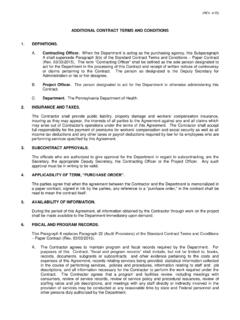Transcription of Croup Fact Sheet - Pennsylvania Department of Health
1 1 Croup Fact Sheet 1. What is Croup ? Croup refers to an infection of the upper airway, generally in children, which obstructs breathing and causes a characteristic barking cough. Croup is most often caused by viruses but occasionally bacterial infections can also cause it. The most common cause of Croup is infection with the Human Parainfluenza virus (HPIV). Croup is most common in the fall but can occur year-round. a. Croup has an unmistakable sound a harsh, repetitive cough similar to the noise of a seal barking. Attacks of Croup often jar children awake and leave them frightened and gasping for breath. Croup can be scary for parents, too, but it's usually not serious. At its worst, Croup can be treated in the doctor's office most of the time. b. The harsh, barking cough is the result of swelling around the vocal cords (larynx) and windpipe (trachea).
2 When the cough reflex forces air through this narrowed passage, the vocal cords vibrate with a barking noise . Most infections occur among children age 6 months to 3 years. c. Seek immediate medical attention if your child: i. Makes noisy, high-pitched breathing sounds when inhaling (stridor), ii. Begins drooling or has difficulty swallowing, iii. Seems agitated or extremely irritable, iv. Struggles to breathe, or v. Develops blue or grayish skin around the nose, mouth or fingernails 2. How long does Croup last? - Croup often runs its course within 3 to 4 days. Your child's cough may improve during the day, but don't be surprised if it returns at night. You may want to sleep near your child or even in the same room so that you can take quick action if your child's symptoms become severe. The breathing problems are caused by the body s response to the infection, rather than the by infection itself.
3 It usually occurs in young children as their airways are smaller and differently shaped than adults', placing them at higher risk. 3. How is Croup spread? Most of the germs that cause Croup are spread through close contact with the respiratory secretions of infected persons or contact with contaminated surfaces or objects. Infection can occur through the eyes, mouth, or nose, and possibly through the breathing in droplets generated by a sneeze or cough. HPIVs can remain infectious in the air for over an hour. 2 4. Is there a vaccine? - No vaccine is currently available to protect against infection caused by any of the HPIVs; however, researchers are developing vaccines against HPIV-1 and -3 infections. Maternal immunity may play a role in protection from HPIV types 1 and 2 in the first few months of life, highlighting the importance of breast-feeding.
4 5. How is Croup treated? - As Croup is most often caused by viruses, antibiotics are not routinely recommended. For most children with mild Croup , care is provided in the home by keeping the child comfortable and providing sufficient liquids and anti-fever medications as needed. For children with moderate to severe Croup , a visit to the hospital may be necessary as well as steroid treatment to reduce inflammation of the airway. 6. Can Croup be prevented? - The risk of infection can be lowered by good hygienic practices. Frequent hand washing and not sharing items such as cups, glasses, and utensils with an infected person should decrease the spread of virus to others. Avoidance of close contact with children with Croup may also help to reduce of the risk of infection to others. 7. For more information about HPIVs, the most common cause of Croup : This fact Sheet provides general information.
5 Please contact your physician for specific clinical information. February 25, 2013

















